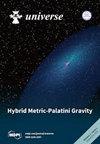能量-动量平方引力:简要概述
IF 2.5
4区 物理与天体物理
Q2 ASTRONOMY & ASTROPHYSICS
引用次数: 0
摘要
在这项工作中,我们回顾了能量-动量平方引力(EMSG)--更具体地说,f(R,TμνTμν) 引力,其中 R 代表利玛窦标量,Tμν 表示能量-动量张量。能动分量的二次贡献具有引人入胜的宇宙学意义,尤其是在宇宙的早期。这些效应在高能条件下占主导地位,使 EMSG 有可能解决广义相对论(GR)中尚未解决的问题,如初始奇点和某些模型中大爆炸核合成的某些方面。该理论在物质和几何之间明确的非最小耦合导致了能量-动量张量的非守恒,这促使我们通过开放系统的不可逆热力学框架来研究宇宙学情景。通过采用这种形式主义,我们从热力学的角度解释了 EMSG 中的能量平衡方程,将其视为对不可逆物质生成过程的描述。由于 EMSG 在真空中收敛于 GR,只有在存在能量-动量分布时才会出现差异,因此这些差异在高曲率区域变得非常重要。因此,在致密天体的致密内核中,与 GR 的偏差预计会非常明显。这篇综述深入探讨了 EMSG 的这些方面,强调它有可能揭示现代宇宙学和引力理论中的一些基本问题。本文章由计算机程序翻译,如有差异,请以英文原文为准。
Energy-Momentum Squared Gravity: A Brief Overview
In this work, we present a review of Energy-Momentum Squared Gravity (EMSG)—more specifically, f(R,TμνTμν) gravity, where R represents the Ricci scalar and Tμν denotes the energy-momentum tensor. The inclusion of quadratic contributions from the energy-momentum components has intriguing cosmological implications, particularly during the Universe’s early epochs. These effects dominate under high-energy conditions, enabling EMSG to potentially address unresolved issues in General Relativity (GR), such as the initial singularity and aspects of big-bang nucleosynthesis in certain models. The theory’s explicit non-minimal coupling between matter and geometry leads to the non-conservation of the energy-momentum tensor, which prompts the investigation of cosmological scenarios through the framework of irreversible thermodynamics of open systems. By employing this formalism, we interpret the energy-balance equations within EMSG from a thermodynamic perspective, viewing them as descriptions of irreversible matter creation processes. Since EMSG converges to GR in a vacuum and differences emerge only in the presence of an energy-momentum distribution, these distinctions become significant in high-curvature regions. Therefore, deviations from GR are expected to be pronounced in the dense cores of compact objects. This review delves into these facets of EMSG, highlighting its potential to shed light on some of the fundamental questions in modern cosmology and gravitational theory.
求助全文
通过发布文献求助,成功后即可免费获取论文全文。
去求助
来源期刊

Universe
Physics and Astronomy-General Physics and Astronomy
CiteScore
4.30
自引率
17.20%
发文量
562
审稿时长
24.38 days
期刊介绍:
Universe (ISSN 2218-1997) is an international peer-reviewed open access journal focused on fundamental principles in physics. It publishes reviews, research papers, communications, conference reports and short notes. Our aim is to encourage scientists to publish their research results in as much detail as possible. There is no restriction on the length of the papers.
 求助内容:
求助内容: 应助结果提醒方式:
应助结果提醒方式:


